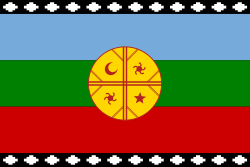Coordinadora Arauco-Malleco
Coordinadora Arauco-Malleco (CAM) is a Mapuche organization dedicated to, what they call, the revindication and recovery of former Mapuche lands. It was founded in 1998, in Tranaquepe, Chile, and is responsible for land occupation in the zones of Tirúa, Contulmo, Cañete and Temucuicui. Protesters from Mapuche communities have used these tactics against multinational forestry corporations and private individuals.
| Coordinadora Arauco Malleco | |
|---|---|
| Participant in the Mapuche conflict | |
 Emblem used by the Organos de Resistencia Territorial (military arm) in sabotage actions awarded by the CAM. The image represents a guemil (symbol of Mapuche iconography) with a Mapuche clava inside it. | |
| Active | 1998–present |
| Ideology | |
| Political position | Far-left |
| Leaders | Héctor Llaitul, Celestino Cordova, Ramón Llanquileo and José Huenchunao[1] |
| Area of operations | La Araucania Region and Bio Bio Region |
| Opponent(s) | |
Several of its members have been judged under anti-terrorist laws left from the Pinochet era because of their violent behaviors. CAM arose from the Mapuche conflict that was revitalized in the late 1990s with the rise of ecologism, and the revindication of indigenismo by politicians of the Concertación. The land rights claimed by CAM can in many cases be traced back to the Occupation of Araucanía in the 1870s and 1880s a period during which many Chileans and foreign settlers acquired lands in Araucanía.
Background
In 1996, some Mapuche communities formed the Lafkenche Territorial Coordinator. In 1998, the conflict of Traiguén arose followed by the later realization of a meeting of communities and a Guillatún. In this meeting the communities in conflict of Arauco and Lumaco participated, the Mapuche Coordinator of Santiago and the Mapuche Organization Meli Wixan Mapu of Santiago. Leaders from communities of Collipulli also joined. During this meeting, the idea of a new meeting in Tranaquepe was raised, only with the Mapuche communities in conflict. In a moment of the meeting, the idea of forming the Coordinadora that they named "Mapuche Coordinator of Communities in Conflict Arauco Malleco" arose.
The first attack perpetrated by the group was the 1st of December 1997, when in the area of Lumaco, three trucks belonging to the company Forestal Arauco were intercepted by community members who would later be known as members of the CAM.This action created a new subjectivity in the Mapuche militancy, modifying its way of doing politics, detonating in a conflict against the security forces. [2][3]
According to historian Jorge Pinto Rodríguez, the organization is the entity that up to 2017 has led the most violent mobilization of the Mapuche people: "He has claimed the figure of the warrior or weichafe -in Mapudungun-," he said. Beyond a specific event, Pinto indicated that the beginnings of this organization are associated with a "lack of response from the State in response to the demands made to mitigate the effects of forestry, mining and hydroelectric projects in La Araucanía or Wallmapu (nation Mapuche), he explained. "They are opposed to a state that they call colonialist and capitalist, and emerge from a stage, at the end of the nineties, of indigenous protests throughout the continent, they take the flag in Chile," said Pinto.[4]
2009 actions and controversy
On the morning of August 12 of 2009, it is alleged by Chilean officials that about 80 Mapuches entered the country estate San Sebastián, located between Collipulli and Angol, and occupied it. The occupation was made in response to their unanswered request to buy the San Sebastián estate by authorities. Sergio González Jarpa, agriculture businessman and owner of the estate, requested to the court of Angol the ouster of the occupants. Carabineros gathered special forces from Araucanía Region and flew in a GOPE unit from Santiago. The ouster begun at around 14.00. As result one young Mapuche Jaime Mendoza Collio was shot dead and one carabinero was injured in the leg.[5] The leader of Mapuche organization Consejo de Todas las Tierras Aucán Huilcamán strongly condemned the actions of the police and called the killing an extrajudicial execution.[6] Later on the Legal Medical Service of Chile stated that the dead Mapuche had been shot from behind in the back.[7] Investigations by Policía de Investigaciones have shown that the Mapuche who was shot, Jaime Mendoza Collío, did not have remains of gunpowder on his hands as Carabineros had suggested.
The attacks of 2009 again brought the CAM issue to the level of government. The Alianza por Chile claimed that the Concertación governments have not done enough to arrest the authors of the attacks and protect private property. On August 19, Chilean President Michelle Bachelet condemned an incident between minister Edmundo Pérez Yoma (DC) and the opposition deputy Gonzalo Arenas (UDI), where Arenas threw an alleged copy of the pardon of former CAM leader Víctor Ancalaf on Pérez Yoma's face.[8] Victor Ancalaf had served 5 years of a 10-year prison sentence for terrorist crimes, which Ancalaf vehemently denies.
Updates
References
- http://diario.latercera.com/edicionimpresa/el-pasado-subversivo-de-hector-llaitul-el-lider-de-los-huelguistas/
- "kom2". www.nodo50.org. Retrieved 2019-01-07.
- Pairicán Padilla, Fernando; Álvarez Vallejos, Rolando (2011). "La Nueva Guerra de Arauco: la Coordinadora Arauco-Malleco y los nuevos movimientos de resistencia mapuche en el Chile de la Concertación (1997-2009)". Revista Izquierdas (10).
- Vedoya, Sebastián. "¿Qué es la Coordinadora Arauco Malleco? Premio Nacional explica el rol del órgano radical mapuche". Publimetro Chile (in Spanish). Retrieved 2019-01-07.
- Confirman muerte de comunero mapuche en enfrentamiento con Carabineros Radio Cooperativa
- Mapuches exigen presencia de obispo Emol
- SML confirma que comunero mapuche recibió el balazo por la espalda El Mercurio
- Fuerte rechazo de Bachelet a incidente entre Pérez Yoma y diputado Arenas El Mercurio
